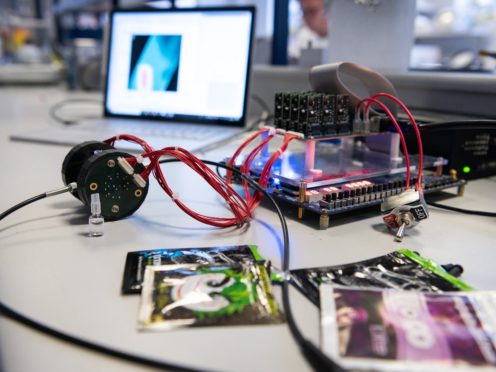
Scientists say they have developed the first simple saliva test to detect if a person has recently taken the psychoactive drug Spice.
The test, which takes about five minutes, can be performed on the spot and identifies whether synthetic cannabinoids have been smoked and if so, at what concentration.
It is hoped that it can be used by healthcare professionals to better treat those who have taken Spice, who may be unconscious, incoherent or experiencing psychosis.
Scientists say the current method of testing for such substances is a urine or blood sample that is sent to a laboratory, with results taking days to come through.

Spice is not a single substance and can be one or a mixture of more than 100 subtly different man-made chemicals, making testing for it difficult.
This means a precautionary approach is often followed for such patients, which may not be the optimal course of treatment, scientists say.
Those undergoing temporary psychosis due to Spice may also be admitted to a psychiatric ward.
Dr Chris Pudney, at the University of Bath, described results as “simple and very accurate” and easy to understand.
“My partner is a psychiatrist and she was telling me that currently they don’t have a way to confirm when they suspect Spice use, they just don’t know for sure,” Dr Pudney said.
“You can test for it with a urine or blood sample that is sent off to a lab, but that takes a few days and so in most cases it’s pointless.
“I started looking into the chemistry and it’s actually similar to something we have developed for detection of biological molecules.
“We decided on saliva because it seemed tractable and less invasive than some other options.”
Dr Pudney contacted colleagues at the university’s Department of Pharmacy & Pharmacology, Department of Computer Science, to explore developing the device.
The university hosted a session with representatives from the NHS, drug charities and homeless charities.
To conduct the test, a saliva sample is taken from the patient and put into a small clear tube.
This tube is placed into the machine, which then uses light to scan for the “fingerprint” of a Spice compound.
Within five minutes, the result comes up on a screen linked to the device.
Dr Jenny Scott, of the Department of Pharmacy & Pharmacology, said: “Spice can be used to ‘zombify’ people, escaping them from the reality in which they find themselves, making them highly vulnerable.
“Two thirds of prison governors report concern about new psychoactive substances use in their prisons, including spice. Use of spice and other synthetic cannabinoids is estimated at about 10% amongst prisoners, and has placed a strain on emergency healthcare.
“Our collaborative research work with homeless people who use drugs has found spice is commonly taken by them also.
“Detection and confirmation of spice use early on when someone is found incoherent gives a chance to start timely treatment for their symptoms.
“Further down the line, we can foresee the kit being used as part of a care pathway that avoids the need to hospitalise some patients if appropriate healthcare can be given where they are.”
It is hoped that medical professionals will be able to trial the device within a year.
The prototype test is featured in the journal Analytical Chemistry.

Enjoy the convenience of having The Sunday Post delivered as a digital ePaper straight to your smartphone, tablet or computer.
Subscribe for only £5.49 a month and enjoy all the benefits of the printed paper as a digital replica.
Subscribe